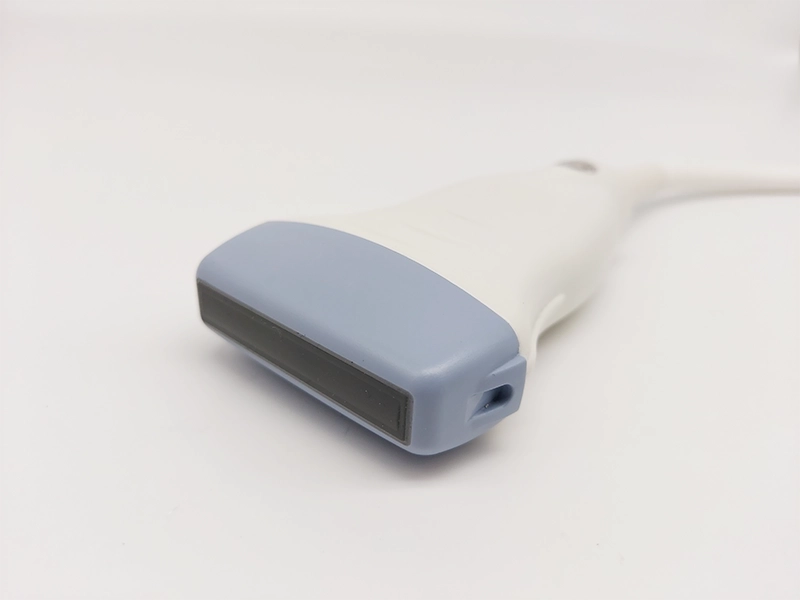Types of Probes and applications
There are a huge range of probes (transducers) available, some suited to certain tasks better than others and it’s important to make sure you have a range of probes to suit your applications. It’s not just the shapes of the probe that differ and dictate what application they are optimised for, the frequency ranges of each probe will also have a bearing on what size of animal they are best suited to. These brief descriptions below aim to give a general outline of the most popular probes for medical and veterinary applications, although other speciality probes are available.

Linear Probe
Straight probe available in a range of lengths from 25mm 'hockey stick' types used for intraoperative applications through to 300mm long ones for back fat scanning of large animals, although the most popular or ‘standard’ linear probes are 38mm or 50mm in length. Linear probes are great for superficial detailed applications.
Medical Applications
MSK, Nerve, Small Parts, Superficial Abdomen, Thyroid, Testes, Eyes, Vascular
Veterinary Applications
as above plus Adrenals, Lymph Nodes, Prostate

Linear Rectal Probe — Vet Only
A linear probe in a different format allowing the operator to insert rectally when carrying out early to mid stage pregnancy diagnosis in large animals. Available, as with most probe with different lengths and frequency options to suit application.
Medical Applications
N/A
Veterinary Applications
Pregnancy Diagnosis (PD) in large animals

Convex Probe
A slightly curved probe, larger footprint for general abdominal scanning coming in a range of frequencies to suit body sizes. Common frequency ranges of these probes are 1.0-5.0MHz for routine adult scanning while some more compact versions will have a slightly higher frequency range of 3.0-8.0 for smaller patients.
Medical Applications
Abdomen, Obs/Gynae
Veterinary Applications
Abdomen in larger breeds and large animals, external PD work in large animals

Microconvex Probe
Straight probe available in a range of lengths from 25mm 'hockey stick' types used for intraoperative applications through to 300mm long ones for back fat scanning of large animals, although the most popular or ‘standard’ linear probes are 38mm or 50mm in length. Linear probes are great for superficial detailed applications.
Medical Applications
Abdomen, Vascular, Carotid
Veterinary Applications
Abdomen in Small Animals, Small Parts, PD, Basic Cardiology

Phased Array Probe
Very small footprint, wide angle probes dedicated to cardiac scans (echocardiology), these probes are designed to offer a view of the heart between ribs in both long and short axis without any rib shadowing obscuring the heart. Phased array probes have lower crystal density than linear or convex probes, but this gives them an important advantage when cardiac scanning - fast frame rates to keep up with the motion of the heart. Available in a wide range of frequencies from very low 1MHz versions for deep scanning up to 15MHz for very superficial cardiac scans.
Medical Applications
Cardiology
Veterinary Applications
Cardiology

Transoesophageal Probe (TOE)
The is a very compact probe providing a wide angle image with fast frame rates. The small probe head is on the end of a flexible cable/shaft, about the width of a finger and is used internally for very detailed cardiology views, these will be considerably clearer than an external scan through the chest. The probe goes down the throat into the oesophagus and the operator ‘drives’ the probe head using tilt and swivel controls mounted further up the cable. A lot of these probes are damaged by patients biting down on them.
Medical Applications
Cardiology
Veterinary Applications
Cardiology (although very rarely used)

Transvaginal Probe (Endovaginal Probe)
A very tight radius small footprint probe on the end of a narrow shaft, providing a wide angle image for internal scans of the female reproductive organs, usually has quite a high frequency as the probe is close to the structures needed to be viewed.
Medical Applications
Gynaecological Exams
Veterinary Applications
Equine Oocyte Retreival

Transrectal Probe (Endorectal Probes)
These probe can either have a very tight radius small footprint probe on the end of a narrow shaft, providing a wide angle image for internal scans just like the transvaginal probe, or have a linear probe along part of the shaft firing sideways. It is possible to have transrectal probes that have a combination of both. Again, like the Transvaginal probe, the transrectal usually has quite a high frequency as the probe is in close proximity to the structures needed to be viewed. As the name suggest the probe is inserted via the rectum.
Medical Applications
Prostate
Veterinary Applications
N/A